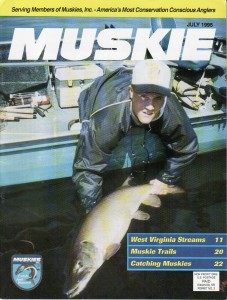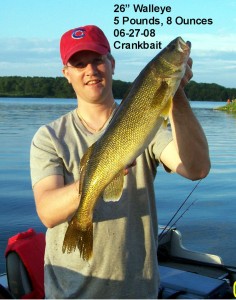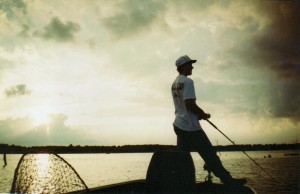With this year’s mild winter resulting in little to no ice fishing for most of northern Illinois, I’m sure that cabin fever must be running wild within most of us. Obviously we will have early ice out this year and one can hope that the lack of ice fishing pressure will correlate over into fantastic spring fishing. Right now is the time to set your game plan for the upcoming open water fishing season. If Shabbona Lake is not on your hit list, I suggest you reconsider. While the lake is most known for its 4 state record muskies, 2 state record hybrid crappies and superb largemouth bass fishing, there are also fantastic fishing opportunities for bluegill, channel catfish, stripers and walleye. Let’s take a close look at these species as our seasonal timetable progresses.
 As we roll into the month of April we will see the water temperatures hit the 50 degree mark. This will trigger a shallow water movement of both largemouth bass and muskies. Target the bass in the shallow bays and flats located on the northern and eastern portions of the lake. A great Rattletrap bite occurs during this time. On sunny days use chrome blue and on cloudy days use hot crawdad or firetiger. Cover the 3 to 6 foot depths with steady moderately fast retrieves. Your average bass will be around 3 pounds with 4 to 5 pounders being commonplace. If the rattletrap bite is off, switch over to a chatterbait in black and blue. Many bass anglers are pleasantly surprised with a muskie because they are sharing the same water during this period. In fact, on many days the bass anglers fishing with the rattletraps are out fishing the muskie anglers with their 12 inch baits! Speaking of muskies…
As we roll into the month of April we will see the water temperatures hit the 50 degree mark. This will trigger a shallow water movement of both largemouth bass and muskies. Target the bass in the shallow bays and flats located on the northern and eastern portions of the lake. A great Rattletrap bite occurs during this time. On sunny days use chrome blue and on cloudy days use hot crawdad or firetiger. Cover the 3 to 6 foot depths with steady moderately fast retrieves. Your average bass will be around 3 pounds with 4 to 5 pounders being commonplace. If the rattletrap bite is off, switch over to a chatterbait in black and blue. Many bass anglers are pleasantly surprised with a muskie because they are sharing the same water during this period. In fact, on many days the bass anglers fishing with the rattletraps are out fishing the muskie anglers with their 12 inch baits! Speaking of muskies…
 If you dream of record fish, the month of the April is when you want to go fishing for muskies. Because there is no closed season on muskies in Illinois, we have the opportunity to fish for them when they weigh their absolute heaviest. Catch a big muskie in April and she can carry 8 pounds of eggs. Catch that same muskie in May is she no longer is a state record. You want to target these fish in two ways. Either go really big or go really small. By small I mean join the bass fishermen with the Rattletraps. By big I mean throw large 9 to 10 inch twitchbaits like Grandmas and Jakes. Each spring there is a natural die off of shad, the muskies favorite meal year round. As these large shad are dying they are easy prey for the muskies. Fish your lures in an attempt to mimic a dying shad. Twitch, pause, pause, twitch, pull….and hopefully whammo!! Again on sunny days use shad colored baits and on cloudy days use the bright lures like firetiger. Target any shallow structure you can find this time of year – remnant weeds, rock piles and fallen trees. Quite often the shore fishermen are catching more muskies than those fishing out of boats. Why?? Because the guys in the boats simply are not fishing shallow enough.
If you dream of record fish, the month of the April is when you want to go fishing for muskies. Because there is no closed season on muskies in Illinois, we have the opportunity to fish for them when they weigh their absolute heaviest. Catch a big muskie in April and she can carry 8 pounds of eggs. Catch that same muskie in May is she no longer is a state record. You want to target these fish in two ways. Either go really big or go really small. By small I mean join the bass fishermen with the Rattletraps. By big I mean throw large 9 to 10 inch twitchbaits like Grandmas and Jakes. Each spring there is a natural die off of shad, the muskies favorite meal year round. As these large shad are dying they are easy prey for the muskies. Fish your lures in an attempt to mimic a dying shad. Twitch, pause, pause, twitch, pull….and hopefully whammo!! Again on sunny days use shad colored baits and on cloudy days use the bright lures like firetiger. Target any shallow structure you can find this time of year – remnant weeds, rock piles and fallen trees. Quite often the shore fishermen are catching more muskies than those fishing out of boats. Why?? Because the guys in the boats simply are not fishing shallow enough.
When the calendar hits May the crappies are the next fish to come shallow. Time it right and you can bring the kids out for a crappie smorgasbord. Crappies will spawn right up on bank in just a couple of feet of water. Quite often you sight fish for them if the water is clear enough. When the kids can see the fish, cast at them and then catch those fish, well that’s just priceless. The key is to keep it simple. A simple small white and red bobber with 1 small split shot about six inches above a #8 hook on 6 or 8 pound test. Hook a small fathead minnow through the eyes and toss it out right in front of that crappie. If the crappies are not right up on the bank, find any swallow water timber that you can. The whole western shoreline of the lake provides such structure for the shore fisherman.
June has both bass and catfish working the shallow water. The largemouth will set up and spawn in early June. Once again depending on water clarity, sight fishing can be extremely fun for bass. Here we are keeping it simple again. Use a #2 hook with either a large nightcrawler or leech and no weight. Cast out the bait out and let it slowly drop directly onto the bed. Pay attention though and be ready. The bass will pick the bait up only to spit it out right away once off the bed. They are not actually picking the bait up to eat it. Immediately set the hook as soon as you see the bass pick it up. There will be multiple bass spawning within yards of each other so be stealthy in your approach. You can literally find bass spawning around the entire perimeter of the lake. Focus on the bays protected by the earthen piers for larger concentrations of fish.
When the lily pads pop out and begin covering the shallow bays, break out the catfish gear. Anchor yourself about ½ a cast from the edge of the lily pads. Work that edge fishing right on the bottom with stink bait, chicken liver, nightcrawlers and leeches. The catfish will hang out directly underneath the outer most edge of the emerging lily pads. Good fields of lily pads develop in the north-east bay and in the south-west bay. With a doubt, the catfish are the most under-fished specie in the lake.
The Bluegills are last to come shallow to spawn and typically this occurs in July. Simply fish the same way you would for the crappies only use leaf worms or wax worms right along the weed edge. Leave the boat at home, bring the kids out and let them at it. Don’t be surprised if a bonus 22 inch bass comes up and takes your bluegill as you are reeling it in.
 Don’t worry, I haven’t forgotten about the walleyes. Mid-summer and walleyes go hand in hand on Shabbona. The hotter the weather gets, the more consistent the walleye fishing gets. Locate the multiple rock piles around the lake when fishing early and late in the day. Most of these rock piles are in 7 to 15 feet of water. Use a bullet sinker with a #2 hook tipped with a jumbo leech. Cast out and leave your bail open. This will allow the bait and sinker to drop straight down instead of swinging back towards the boat. Essentially you cover more lake bottom with each cast this way. Slowly bounce the leech on the bottom back to the boat. When you think you are fishing slow enough, slow down some more. When you feel a hit, drop your rod and open your bail. When the fish takes off, close your bail and set the hook. During mid-day, fish the 10 to 20 foot drop-offs located around the standing timber in the lake. Utilize the same bottom bouncing tactic. For the trophy walleyes, fish the standing timber in the middle of lake with slip bobbers. Fish right next to the standing timber 10 to 15 down in 30 to 35 feet of water. If you are not losing hooks then you are not fishing close enough to the structure.
Don’t worry, I haven’t forgotten about the walleyes. Mid-summer and walleyes go hand in hand on Shabbona. The hotter the weather gets, the more consistent the walleye fishing gets. Locate the multiple rock piles around the lake when fishing early and late in the day. Most of these rock piles are in 7 to 15 feet of water. Use a bullet sinker with a #2 hook tipped with a jumbo leech. Cast out and leave your bail open. This will allow the bait and sinker to drop straight down instead of swinging back towards the boat. Essentially you cover more lake bottom with each cast this way. Slowly bounce the leech on the bottom back to the boat. When you think you are fishing slow enough, slow down some more. When you feel a hit, drop your rod and open your bail. When the fish takes off, close your bail and set the hook. During mid-day, fish the 10 to 20 foot drop-offs located around the standing timber in the lake. Utilize the same bottom bouncing tactic. For the trophy walleyes, fish the standing timber in the middle of lake with slip bobbers. Fish right next to the standing timber 10 to 15 down in 30 to 35 feet of water. If you are not losing hooks then you are not fishing close enough to the structure.
Mid-summer bass can be fished exactly like the walleyes and even in the same locations. However, early and late in the day can provide some excellent top water experiences. Push yourself way back into the slop and use a weedless mouse or frog over the matted surface. Move the lure about a foot at a time and pause. Especially make sure you pause the bait when you come across an open surface area within the matted weeds. Remember to not set the hook until you feel the weight of fish and not on the surface explosion. Another option is to follow the weed line and cast parallel to it with a Tiny Torpedo or a Devils Horse. Fish these baits by popping them causing the propellers to spin and spit. Be sure to pause and allow the bait to sit as 9 out 10 strikes will occur on the pause.
As temperatures begin to drop and fall is in the air, the stripers are extremely active. You can fish with chicken liver along the deep weed edges close to drop offs. However, don’t fish as slowly as you would for the walleyes. The stripers like a bait that is moving. Lift and drop the bait more vigorously off the bottom. Also watch for schools of shad being pushed up shallow into the weed edge. Both the stripers and bass will be busting through these schools. Use a jointed J-11 Rapala in any color as long as it is blue. Shad have an iridescent bluish hue. Again, fish aggressively through the schools of shad as you have to make your bait stand out amongst thousands of the real thing!
Of course we can’t talk about fall fishing without talking muskies again. There are 2 tactics that work well in the fall. Fish the swallow timber with large jerkbaits like Suicks or large bucktails like Cowgirls. Concentrate on these areas early and late in the day. During mid-day troll crankbaits like Depth Raiders and Super Shad Raps in and around the schooling shad. Pick your trolling depth by watching the depth of the schooling shad on your sonar. If the schools are topping out at 6 feet, then run your lures at that depth. If the schools are topping out at 11 feet, then run your lures at that depth. Muskies feed in an upward direction so make sure you are not running your lures below them.
By focusing on the right specie at the right time of year, you can up your fishing success on Shabbona Lake. Anytime fishing turns into catching makes for a special day. Put the odds in your favor and you too will be doing a lot less “practice casting.” May 2012 be a productive catching season for you and be sure to take advantage of the local fisheries that we have!
